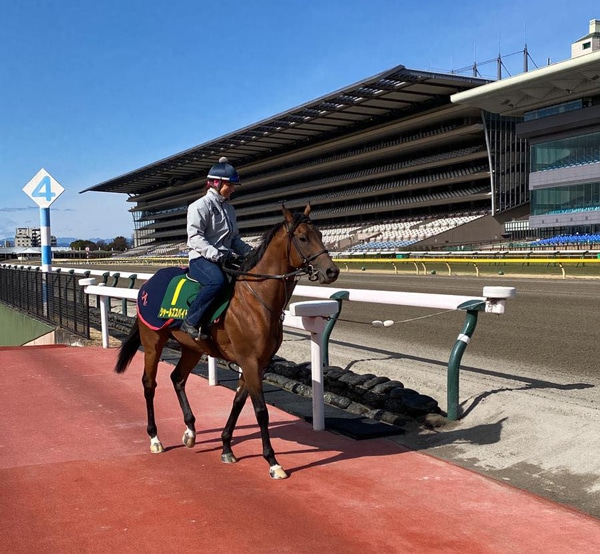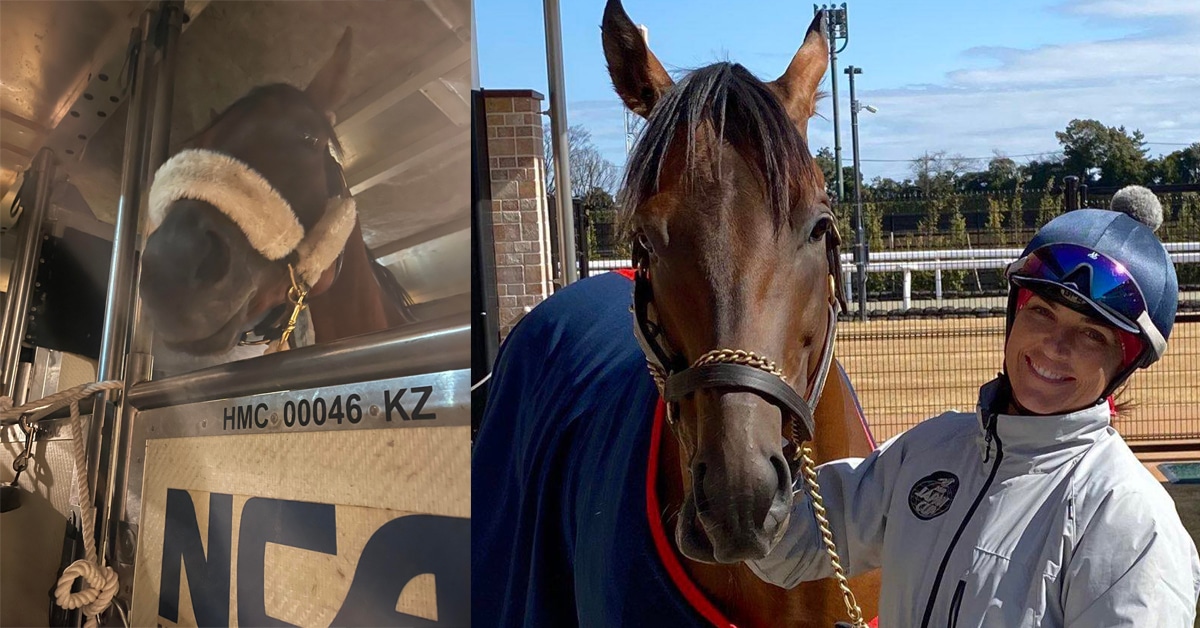It’s not every day that you travel across the country ‒ or for that matter, across two continents ‒ with a stakes-winning racehorse. Yet that dream came true for Allyson Walker Hartfield when she travelled alongside Shirl’s Speight from the US to Japan in preparation for the upcoming (G1) February Stakes at Tokyo Racecourse.
Owned and bred by Charles Fipke, the son of Speightstown is trained by Hall of Famer Roger Attfield. The veteran trainer entrusted the care of Shirl’s Speight (SS) to his long-time assistant, Hartfield, who kindly took the time to share some details about their journey with Canadian Thoroughbred.
Can you tell us about your journey with Shirl’s Speight from the US to Japan?
“We loaded up around noon Monday, February 6, at Payson Park [Florida] where Shirl has been training since he ran at the Breeders Cup. We traveled with Brook Ledge Transport. The quarantine stipulations were that he needed to travel alone to Chicago, and the tractor-trailer needed to be disinfected before loading.
We shipped into the old Arlington Park on February 7, which was sad to see empty and the tear-down beginning. It took us roughly 23.5 hours to get there. He was a good traveller; we stopped around every four hours for gas, breaks, water checks, and feeding. We stayed in the facility for 11 hours where the USDA [United States Department of Agriculture] endorsed the health papers and quarantine officers checked the horse over.
We loaded back up at CEEC on the same van to head to the airport [ORD – Chicago O’Hare International Airport] around 11:30 p.m. Once we got there, we transferred from the van to the shipping stall, which is like a large metal box stall, matted walls, room for a little storage, hay, and water. It is very similar size to a box stall on a transport van; it can be set up for three standing stalls for shared travel.
The stall is on a conveyer belt-like platform that moves along a grid to the edge and then lifts up like any other large cargo would onto the plane’s side (or front of the plane). It is locked into the same grid-like slides and locks to hold it in place for the duration of the flight.
Our plane departed at 2:40 a.m. on February 8, and after 5.5hrs, we landed in Anchorage, Alaska, for fuel. On the descent into Anchorage we did catch a glimpse of the Northern Lights, which was amazing. There was some seating upstairs behind the cockpit on the plane, and a professional plane groom was with me at all times when checking on Shirl during the flight.
The second leg of the trip was just over six hours of airtime, and we flew into Narita International Airport. The unloading as much the same as loading, transferring along the belt to the front of the plane, lowering down, and then the box was driven to the van waiting just outside of the gate. We loaded him onto a JRA transport van and went back into the airport to clear customs ourselves. The process took roughly an hour, and then we began our two-hour journey to Tokyo Race Course.
What was it like travelling with Shirl?
The travel experience with Shirl was long; it was around 60 hours, start to finish. My priorities were making sure he was comfortable, staying hydrated, and eating as close to his normal schedule as possible. Both the Brook Ledge staff and U.S. Equine staff on the ground and plane were helpful, kind, and great horsemen; they truly made the trip as easy on the both of us as possible. He was such a good boy through each stage. He stayed settled, relaxed and was brave.
What is the quarantine process involved for both SS and yourself?
Upon arrival, we went into the new TRC international quarantine facility, which is nothing short of amazing. There are six two-stall barns in the middle of a 300-metre dirt track; each has a TV lounge, washing machines and dryer, wash rack, two tack rooms, bathrooms, and showers. You can heat the stall area if wanted, there is a covered round pen and a horse scale room, all fenced in the middle of their infield. Shirl’s Speight’s strict quarantine is five days long, where they collect both blood and nasal swabs to run tests on, and humans must shower and change their clothes upon both entry and exit of the barn.

Allyson and SS on the Tokyo track.
There is a JRA clubhouse right outside of the barn area, and each of us (myself, my interpreter, and our vet, who are with me at all times) have our own locker rooms where one side is for our IN barn clothes, a shower in the middle, and the OUT clothes on the opposite end.
After February 15th and the final quarantine check, the showers can stop, but in-clothes and out-clothes must still remain in separate areas. Shirl’s Speight was able to use the 300m dirt track anytime but was not able to train on the main track until February 12. There is only racing here on weekends and all horses train at training facilities off-track, so Shirl’s Speight is the only horse on the grounds. He is handling it very well. The track is amazing to train on all by ourselves.
What does the preparation look like for the upcoming February Stakes?
“The prep for the stake is largely governed by Shirl’s Speight acclimation. He had a walk day to recover Friday, a light jog and canter on the 300m track Saturday, but trained Sunday as the JRA required Shirl’s Speight to take a gate test on February 13, so Roger wanted him to get a feel for the track and the deep beach-sand-like dirt. The gate test required Shirl’s Speight to load, stand, back out, reload, and break. Roger decided to let Shirl’s Speight have a small 1/4 mile blowout off the gate to open up his lungs and get a feel as to how he would handle the dirt. The gate crew was extremely impressed with his manners and breaking. Shirl’s Speight handled it well and was happy to do it. Roger arrives on February 15th and will plan to train him normally as long as he stays happy and healthy.
I cannot stress enough how accommodating, and kind the people working at the JRA have been. They literally bring me things before I even think to ask. They are the most amazing hosts and truly want SS to acclimate as smoothly and as well as possible.


